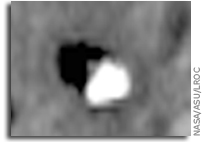 Scooping the Soviets, Paul Spudis
Scooping the Soviets, Paul Spudis
“The team at Jodrell Bank assumed that the mission was over, surmising that Luna 9 probably hit the Moon too hard or was designed as a crash lander. Then to their astonishment, the probe began transmitting radio signals and the observatory recorded them, uncertain as to their meaning. Lovell thought – suppose these signals were simply an ordinary telefax communication? If these transmissions were pictures of the lunar surface, perhaps the signals the observatory recorded could be read by a commercial facsimile machine. But Jodrell Bank Observatory had no such machine; the observatory was a scientific laboratory, which in those days displayed its received radio signals in the form of line graphs made by paper strip recorders.”
Lunar Orbiter Photo Techs talk About Looking for Surveyor 1 & Luna 9 Landing Sites
This audio is from a Lunar Orbiter tape made on 24 Feb 1967. In the tape you can hear the techs talking about whether the “Surveyor” or “Luna 9” spacecraft could be seen in any images. Both spacecraft had landed on the lunar surface.
Lunakhod One Is Still In Its Parking Location

“Luna 17, carrying Lunokhod 1, landed on the flood basalt surface of Mare Imbrium on 17 November 1970, after entering orbit on 15 November. Today’s Featured Image of Luna 17 and Lunokhod 1 was obtained during a low altitude (33 km) pass providing the highest resolution view yet of the landing site.”
NASA LRO Image: Luna 24 Sitting On The Lunar Surface
 Luna 24 landed on the northwestern rim of a 64 m diameter impact crater, on the volcanic plains of Mare Crisium. Enlargement of lander at lower left, NAC M174868307L [NASA/GSFC/Arizona State University].
Luna 24 landed on the northwestern rim of a 64 m diameter impact crater, on the volcanic plains of Mare Crisium. Enlargement of lander at lower left, NAC M174868307L [NASA/GSFC/Arizona State University].
Three Soviet missions (Luna 16, Luna 20, and Luna 24) successfully collected and returned pieces of the lunar surface. Before the successful Luna 24 sample return mission in August 1976, Luna 23 was sent two years earlier (November 1974) to nearly the same location in Mare Crisium, but was unsuccessful.
Luna 24 landed in Mare Crisium on 18 August 1976 to complete the unfinished mission of Luna 23. The landing sites of Luna 23 and 24 are only 2.3 km apart. The region of Mare Crisium where they landed is a typical smooth mare surface with little relief in the immediate vicinity. There are numerous secondary craters scattered across the region, and Luna 24 landed on the edge of one of these. The secondary craters are the result of an impact to the northeast of the landing site, perhaps from the crater Giordano Bruno.
More information and imagery.
NASA LRO Image: Luna 23’s Rough Landing On The Moon
 Unfortunately, Luna 23 experienced a malfunction and hit the surface at a very high velocity. Contact was maintained between Earth and the spacecraft after landing, but a sample could not be acquired. At the time, the cause of the failure was not known, but it seemed probable that the whole spacecraft tipped over upon landing at an unexpectedly high velocity. Indeed, the high resolution LROC NAC image (below) shows the spacecraft lying on its side!
Unfortunately, Luna 23 experienced a malfunction and hit the surface at a very high velocity. Contact was maintained between Earth and the spacecraft after landing, but a sample could not be acquired. At the time, the cause of the failure was not known, but it seemed probable that the whole spacecraft tipped over upon landing at an unexpectedly high velocity. Indeed, the high resolution LROC NAC image (below) shows the spacecraft lying on its side!
More information and imagery.
Luna 3 And the Far Side of the Moon
 Oct. 7, 1959: Luna 3’s Images From the Dark Side, Wired
Oct. 7, 1959: Luna 3’s Images From the Dark Side, Wired
“Luna 3’s mission objective was to provide the first photographs from the moon’s far side. To achieve this, the probe was equipped with a dual-lens 35mm camera, one a 200mm, f/5.6 aperture, the other a 500mm, f/9.5. The photo sequencing was automatically triggered when Luna 3’s photocell detected the sunlit far side, which occurred when the craft was passing about 40,000 miles above the lunar surface. Luna 3’s camera took 29 photographs over a 40-minute period, covering roughly 70 percent of the moon’s far side. The photographs were developed, fixed and dried by the probe’s onboard film processing unit. Seventeen images were successfully scanned and returned to Earth on Oct. 18, when Luna 3 was in position to begin transmitting.”
 Keith’s note: Um, the ‘dark side’ of the Moon is constantly changing as the Moon spins on its axis – once a month. What Luna 3 photographed was the “far side” of the Moon. If the side of the Moon that was photographed by Luna 3 was indeed “dark” then there’d be nothing in the photo, right?
Keith’s note: Um, the ‘dark side’ of the Moon is constantly changing as the Moon spins on its axis – once a month. What Luna 3 photographed was the “far side” of the Moon. If the side of the Moon that was photographed by Luna 3 was indeed “dark” then there’d be nothing in the photo, right?
